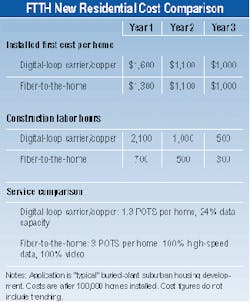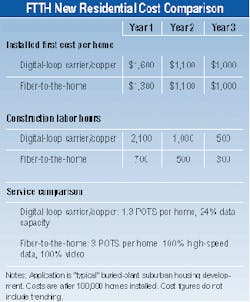Verizon staffers find fiber-to-the-home cheaper than copper
By STEPHEN HARDY
APPLICATIONSWhile many complain that the regional Bell operating companies have dragged their feet when it comes to implementing new technologies in access networks, several have taken a close look at the ultimate in infrastructure, fiber-to-the-home (FTTH). BellSouth has already announced trials of passive-optical-network (PON) technology based on Full Service Access Network (FSAN) specifications. At a recent market seminar, a representative from Verizon Communications (formerly Bell Atlantic) revealed research indicating that fiber is a more economical approach than copper in high-speed access networks.
Speaking at the Newport Conference on Fiber-optics Markets sponsored by KMI Corp. (both KMI and Lightwave are owned by PennWell Corp.), Rick Hofman, director of residential and transport design at Verizon, described his company's investigations into FTTH. Hofman said that as far as Verizon is concerned, any FTTH approach must be simple to implement and maintain, provide a low fixed cost, require few man-hours, and support the residential services the carrier's customers could reasonably expect. These include standard circuit-switched POTS, high-speed (10-Mbit/sec Ethernet) data, and video distribution.
Hofman pointed out that the low man-hour requirement was particularly important, saying that it was significantly easier to find more money than it was to find extra crew. On the services side, he said that the requirement to support current services such as POTS, dial-up modem, and facsimile-as well as provide video services in a method compatible with currently deployed set-top boxes-would drive Verizon away from infrastructures based exclusively on Internet Protocol or ATM.
Several breakthroughs, technological and otherwise, make this a propitious time for FTTH, said Hofman. First, advances in aerial fusion splicing make FTTH more feasible for carriers such as Verizon that have a significant amount of plant strung along telephone poles. Hofman strongly favors fusion splicing over connectors, because splicing is less expensive and easier to accomplish. In fact, Hofman says that fiber cable can now be strung as quickly as small copper cabling. Other advances include self-supporting fiber-cable and cable-drop architectures, lower cable prices, the availability of cable-TV and video-transmission equipment, and the overall demand for high-bandwidth services.But perhaps the most important advance is Verizon's development of a PON approach that takes advantage of existing digital-loop carriers and other installed equipment and technology. Hofman said the PON is not based on FSAN, but was tailored for Verizon's requirements. In the central office, a distribution shelf interfaces with a digital-loop carrier for voice and an Ethernet switch for data, then feeds the streams to a WDM splitter. This splitter also receives video input from cable-TV and satellite feeds, combines all three traffic types, and sends them to smaller passive splitters in the field. Each of these splitters would feed four fiber drops to individual homes, where an optical-to-electrical converter unit would act as the interface to the home. The network would support bidirectional traffic at 1,310 nm and unidirectional traffic at 1,550 nm.
Verizon, working closely with Marconi Communications, has researched the performance and expense of such an architecture and concluded that it compares favorably with copper-based alternatives, particularly in first costs and man-hours (see Table).
Looking toward the future, Hofman suggested that FTTH should be implemented in all new housing and rehabilitation applications. He expected that a significant effort in new housing applications would begin in 2002. Such applications represent 2% to 3% of Verizon's total plant; rehabilitation would affect 3% to 5% of the carrier's plant each year, he said.
Despite such strong numbers, Hofman predicted that significant FTTH deployment represented a "10-year, 20-year, 30-year project." He asserted that carriers would have to rely on FTTH within 50 years to meet user demands for bandwidth. He declined to comment on the specifics of Verizon's FTTH rollout schedule.

